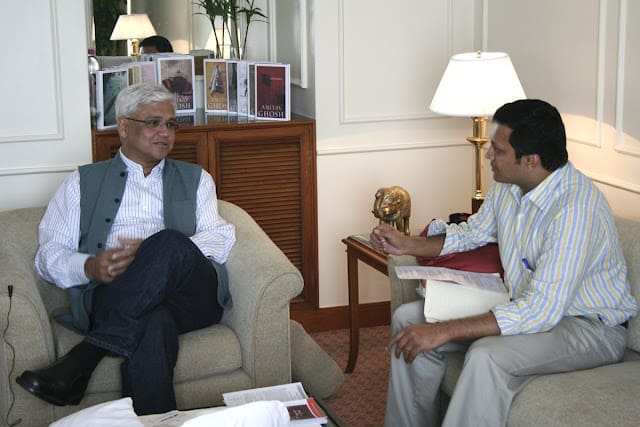 |
| The author Amitav Ghosh in conversation with me, then short-haired and propah. Photo © Rediff.com – All rights reserved. |
The Hungry Tide is set in the Sunderbans and one of its protagonists is an Indian-American scientist named Piyali Roy who arrives in the region to study the Gangetic River Dolphin. When Ghosh went about his research for the book, he wrote to a number of dolphin researchers. Only one responded – Prof. Helene Marsh of the James Cook University in Queensland, Australia. She pointed him to her student who was researching Irrawaddy river dolphins in Cambodia. With this scientist, Ghosh traveled up the Mekong and “saw the research absolutely at firsthand”.
“The Irrawaddy Dolphin,” Ghosh told me, “is a coastal species. “What’s special about it is that some branches of it live in freshwater, some live in brackish and some live in coastal regions. Dolphins are incredibly adaptable.”
And then he asked me, “Have you seen the dolphins in Goa?”
Somewhat ignorantly, I said yes and no.
Yes, because I have seen dolphins off the coast of Kapu (formerly Kaup), near Udupi in coastal Karnataka. And no, because those weren’t river dolphins as far as I knew.
Kapu is a beach of incredible beauty, with conical spires of rock rising straight out of the sea and a lighthouse atop one of them. Usually, the rocks are clear out of the water and you can climb all the way up to their summits. In August 1998, I went to Kapu just when the monsoon had taken a breather. The tide was full, though, and the cones were cut off by a sizable tidepool that I, a swimmer skilled only in drowning, had no intention of testing. It was the first time I had seen the beach like that, with deep water all the way up to the lip of the shore, and its beauty was forbidding and fascinating at the same time.
We heard a group of tourists exclaim and point to the water beneath one of the rocks. Small humps of bluish grey broke out of the waves. It was a pod of about six dolphins. They were large – each about eight feet long – and they bobbed in and out of the water with smooth, sinuous movements. I remember being amazed that these dolphins swam so close to the beach, and that they approached people without fear. Later, I learned that both these traits were part of the dolphin’s personality.
Reading Nature’s Spokesman, a set of published columns by the late naturalist, photographer and writer (also illustrator and poet) M. Krishnan edited by Ramachandra Guha, I came across a piece (Five Encounters) in which Krishnan recounts a strange meeting with dolphins in Point Calimere on the Coromandel Coast. Wading out to sea, Krishnan is suddenly accosted by a school of these small whales – small only in comparison to orcas and humpbacks, for he remembers them as being strong, muscular and eight feet long. He also remembers, as he is standing there in shoulder-high water with his camera raised high above his head, that dolphins have razor-sharp teeth and a bite that could snip his hand off (well, we know that dolphins can kill sharks).
Back to Amitav Ghosh. After I mumbled my noncommittal reply about dolphins in Goa, he went on to tell me about the popular dolphin cruises in the Mandovi estuary. “The sort of dolphin I wrote about in The Hungry Tide – the Irrawaddy Dolphin – is actually the dolphin that they show tourists in Goa, where at the mouth of the Mandovi river they have a breeding pod. People don’t know what kind of dolphin it is so they say it’s a porpoise!”
 |
| Distribution of Orcaella brevirostris: warm coastal waters and rivers from the Bay of Bengal to Northern Australia (maps – copyright IUCN) |
There are river dolphins in the large river mouths of India – the Indus and the Gangetic River Dolphins are believed to be the same species by some cetologists and have been observed in the relatively unpolluted waters of the Chambal. Whether they have been studied in the Mandovi and the Zuari and the great estuaries of the south Indian rivers I do not know.
But something tells me Amitav Ghosh may be right.
UPDATE – June 27, 2011:
I met Amitav Ghosh again in Mumbai in connection with the second book of his Ibis trilogy, River of Smoke, and reminded him of this conversation that we had in 2008. The great author graciously published a link to this post on his blog.
- TL;DR – Death Stalks Like A Marabou Stork - July 24, 2024
- Dimorphic Egret – Meet this East African mystery bird - June 8, 2024
- Encounter: Northern Treeshrew in Arunachal Pradesh - May 19, 2024

One thought on “Talking dolphins with Amitav Ghosh”